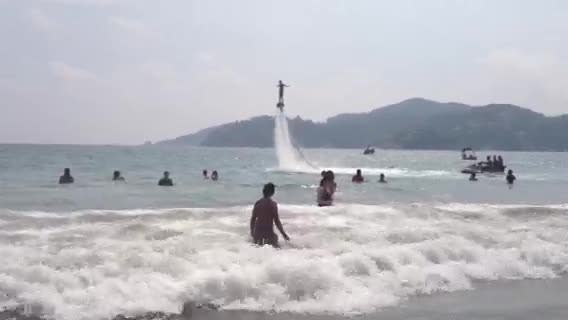A new beach sport: jetpack flying

A few months ago, I was hanging out on the beach in San Juan, Puerto Rico, when I saw a guy flying over the ocean. Something like a snowboard was tucked under his feet, a thick red hose was attached to the board, and he seemed to be happily riding a plume of water. A small watercraft with an onboard motor was guiding him. Sunbathers on Isla Verde Beach stood in their tracks to watch the sci-fi-like event.
Then last month, I was in Zihuatanejo, swaying on hanging beach bed at the Viceroy Hotel, and this mirage appeared again. A guy in a jetpack was hovering over Playa La Ropa, doing flips, executing perfect dives from midair, then emerging, dolphin-like, from the gentle waves. He seemed to be surfing the air. I grabbed my iPhone and started filming.
The hose is typically around four inches wide and more than 30 feet long, which means that “pilots” can rise 30 feet in the air. Despite its name, the pack itself is not the power source. A 200+ horsepower motor sends seawater up into the hose, enabling fliers to reach speeds of up to 30 mph. Some instructors have taught people to fly in as little as six minutes (though most people need longer, and pilots should be strong swimmers and comfortable with getting their faces wet). Expect to fly for 15-20 minutes the first time, 30 minutes for subsequent flights. It usually costs around $200.
The name Jetlev, which you’ll see pop up all over the U.S., is the one most associated with the sport, but the brand name is transitioning to Jetpack America. The sport itself is so new that even the name of it seems in flux; in some places in the Caribbean it goes by the name of “flyboarding.”
A year ago, the new watersport made a splash, so to speak, when a Grand Rapids, Mich., couple had what might have been the country’s first jetpack wedding. Now it’s mainstreaming, turning up in Cancun, Cabo San Lucas, Hawaii, Key West, San Diego, and Grand Cayman. Jetlev Hawaii will pick up guests at their hotels and whisk them off to Maunalua Bay (it’s a three-hour excursion, door to door). You can jetpack in Key West, via Jet Pack Adventures, even if you’re off a cruise ship and only in port for a day. In Cancun, Jetpack Mexico is located in La Isla Mall in the hotel zone. (It’s always best to call first, as this is a nascent sport, demand comes in fits and starts, and operators can disappear as quickly as they appeared.)
Given that Newport Harbor in Orange County, Calif., where the Michigan couple got hitched, is one of the largest recreational boat harbors on the West Coast, it’s no wonder that jetpacking has appeared there. Newport Harbor’s Jetpack America experience consists of a safety video, training, and 15-20 minutes of flight time. Adventurous watermen can learn fancy maneuvers like donut turns, walking on water, and underwater moves. The Newport Beach flight center is also the lift-off point for record-breaking flights to Catalina Island and L.A. Last year, JetPack America president Dean O’Malley made the unprecedented flight in over four hours.
